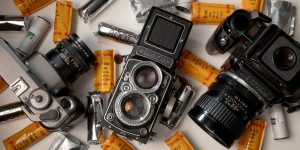
Medium format cameras. A distinct blend of performance, image quality, and craftsmanship can be found in each of these medium format cameras. enabling photographers to express their creativity and produce breathtaking images with unmatched depth and detail. Whether the Fujifilm GFX 100S’s small size and adaptability appeal to you. The Hasselblad X1D II 50C’s classic style or the Phase One XF IQ4 150MP’s superior image quality. To ignite your enthusiasm for photography and take your work to the next level, there is a medium format camera available.
MEDIUM FORMAT CAMERAS
Medium format photography offers photographers a unique and immersive experience. With a larger image sensors providing unparalleled detail, dynamic range, and image quality. Whether you’re a professional seeking the ultimate tool for commercial work or an enthusiast looking to elevate your photography to new heights, medium format cameras offer a level of performance and image quality that is unmatched by smaller formats.
1. Fujifilm GFX 100S;

MEDIUM FORMAT CAMERAS
– The Fujifilm GFX 100S is a powerful medium format mirrorless camera that combines a large 102-megapixel sensor with advanced image processing technology.
– It features a compact and lightweight design compared to traditional medium format cameras, making it more portable and versatile for a variety of shooting situations.
– The GFX 100S offers 5-axis in-body image stabilization (IBIS), fast and accurate autofocus, and 4K video recording capabilities, making it suitable for both still photography and videography.
– With its exceptional image quality, robust build quality, and intuitive controls, the Fujifilm GFX 100S is a favorite among professional photographers and enthusiasts alike.

MEDIUM FORMAT CAMERAS
– The Hasselblad X1D II 50C is a sleek and stylish medium format mirrorless camera that combines a 50-megapixel sensor with Hasselblad’s legendary image quality and craftsmanship.
– It features a compact and ergonomic design, with a large 3.6-inch touchscreen display for intuitive operation and composition.
– The X1D II 50C offers a wide dynamic range, accurate color reproduction, and Hasselblad’s renowned natural color solution (HNCS). Ensuring stunning image quality in every shot.
– With its minimalist design, exceptional image quality, and Hasselblad’s iconic heritage. The X1D II 50C is a favorite among fashion photographers, landscape photographers, and discerning enthusiasts.
3. Phase One XF IQ4 150MP;

MEDIUM FORMAT CAMERAS
– The Phase One XF IQ4 150MP is the pinnacle of medium format digital photography. Boasting an astonishing 150-megapixel sensor and unparalleled image quality.
– It features a modular design, allowing photographers to customize their setup with a variety of lenses, viewfinders. And accessories to suit their specific shooting needs.
– The XF IQ4 150MP offers industry-leading resolution, dynamic range, and color accuracy. Making it the ultimate tool for high-end commercial photography, fine art, and landscape photography.
– With its unmatched image quality, modular design, and extensive range of features. The Phase One XF IQ4 150MP sets the standard for medium format digital photography. And is the camera of choice for professional photographers at the top of their field.
Summary
Using a film or digital sensor that is larger than a full-frame sensor, medium format cameras produce images with remarkable color fidelity, dynamic range, and detail. Although recent mirrorless models have made them more widely available, they are preferred for professional photography like as landscape, fashion, and advertising. The Pentax 645Z, Hasselblad X2D, and Fujifilm GFX series are popular models.